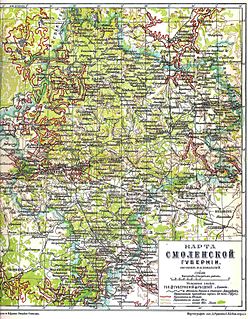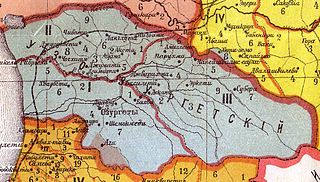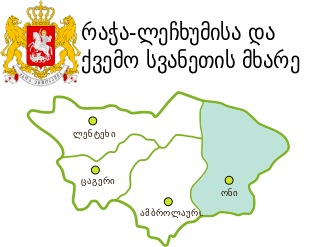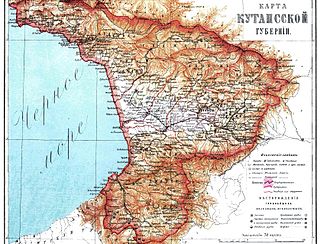
Guria is a region (mkhare) in Georgia, in the western part of the country, bordered by the eastern end of the Black Sea. The region has a population of 113,000 (2016), with Ozurgeti as the regional capital.

Smolensk Governorate, or the Government of Smolensk, was an administrative division of the Tsardom of Russia, the Russian Empire, and the Russian SFSR, which existed, with interruptions, between 1708 and 1929.

The Republic of Guria or the Gurian Peasant Republic was an insurrection that took place in the western Georgian province Guria, against Imperial Russia, prior to and during the Russian Revolution of 1905.

A mkhare is a type of administrative division in the country of Georgia. It is usually translated as "region".

Eristavi was a Georgian feudal office, roughly equivalent to the Byzantine strategos and normally translated into English as "duke". In the Georgian aristocratic hierarchy, it was the title of the third rank of prince and governor of a large province. Holders of the title were ex-officio commanders of a military 'banner', wore a distinctive dress, ring, belt and spear and rode a particular breed of horse.
The 1990 Soviet Top League season was the 53rd since its establishment. Spartak Moscow were the defending 12-times champions. The league was shortened and a total of fourteen teams participated. By the start of the season both Georgian teams have withdrew followed by another withdrawal from Žalgiris at the start of competition. The league consisted of ten teams contested in the 1989 season and the Army club promoted from the Soviet First League. The representatives of the Baltic states as well as Georgia chose not to take part in the competition.

The Principality of Guria was a historical state in Georgia. Centered on modern-day Guria, a southwestern region in Georgia, it was located between the Black Sea and Lesser Caucasus, and was ruled by a succession of twenty-two princes of the House of Gurieli from the 1460s to 1829. The principality emerged during the process of fragmentation of a unified Kingdom of Georgia. Its boundaries fluctuated in the course of permanent conflicts with neighboring Georgian rulers and Ottoman Empire, and the principality enjoyed various degrees of autonomy until being annexed by Imperial Russia in 1829.

The House of Gurieli was a Georgian princely (mtavari) family and a ruling dynasty (dukes) of the southwestern Georgian province of Guria, which was autonomous and later, for a few centuries, independent. A few ducal rulers of the dynasty also rose in the 17th-18th centuries to be kings of the whole western Caucasus in place of the hereditary Bagrationi kings of Imereti.
Giorgi III Gurieli, of the Georgian House of Gurieli, was Prince of Guria from 1669 to 1684 and King of Imereti from 1681 to 1683. He was energetically involved in civil wars in western Georgian polities, which he sought to bring under his sway. He was killed in battle while trying to recover the lost throne of Imereti.
Giorgi IV Gurieli, of the House of Gurieli, was Prince of Guria from 1711 to 1726, and a king of Imereti in western Georgia in 1716. He was installed as regent of Guria by his father, Mamia III Gurieli, then the king of Imereti, in 1712. In 1716, he seized the crown of Imereti, but was forced to abandon the enterprise later that year. Returning to Guria, his rule was challenged by a faction of local nobility, which included his mother Elene and brother Kaikhosro III Gurieli. He was finally able to crush the opposition after making peace with Bezhan Dadiani, Prince of Mingrelia.

Tiflis Governorate was one of the guberniyas of the Caucasus Viceroyalty of the Russian Empire with its centre in Tiflis. In 1897 it constituted 44,607 sq. kilometres in area and had a population of 1,051,032 inhabitants. The governorate used to border Elisabethpol Governorate, Erivan Governorate, Kutais Governorate, Zakatal Okrug, Dagestan Oblast, Terek Oblast, and Kars Oblast. It covered present southeastern Georgia, northern Armenia and northwestern Azerbaijan.

Oni is a district of Georgia, in the region of Racha-Lechkhumi and Kvemo Svaneti. Its main town is Oni.
The Nakashidze is a noble family in Georgia, one of the princely houses hailing from the province of Guria. In the Principality of Guria, they held the hereditary office of Receivers of Ambassadors, as well as the bailiffship (mouravi) of Shemokmedi, Ozurgeti, and Chochkhati. After the Russian annexation of Guria (1828), the family was received among the princely nobility of the Russian Empire. The family produced several military figures and bureaucrats in the Imperial Russian service into the 20th century.
Guriis Eristavi or Eristavi of Guria, was a Georgian noble family, a branch of the Shervashidze, dynasts in Abkhazia. Their surname derives from the title of eristavi ("duke") the family held under the suzerainty of the reigning princes of Guria in southwest Georgia. In the 18th century the family bore the name Eristavi-Sharvashidze (ერისთავი-შერვაშიძე). In 1850, the family was received among the princely nobility of the Russian Empire as knyaz Eristov-Guriisky.

The 1841 rebellion in Guria was a conflict in the former Georgian principality of Guria, at that time part of the Georgia-Imeretia Governorate of the Russian Empire, that took place as a reaction to the government's newly introduced duties and taxes for the Georgian peasants. The rebels, joined by several nobles, were initially successful in overrunning much of Guria, but they were finally defeated by the Russian army and the allied Georgian nobility in September 1841.

The Kutais Governorate was one of the guberniyas of the Caucasus Viceroyalty of the Russian Empire. It roughly corresponded to most of western Georgia and most of Artvin Province of Turkey between 1878 and 1917. It was created out of part of the former Georgia-Imeretia Governorate in 1846. It also included Akhaltsikhe uyezd before its cession to the Tiflis Governorate in 1867.
The Georgia-Imeretia Governorate was a short-lived governorate (guberniya) of the Caucasus Viceroyalty of the Russian Empire, administered from Tiflis (Tbilisi). Roughly corresponding to modern Georgia and parts of Armenia and Azerbaijan, it was created in 1840 from the territory of the Georgia Governorate and the oblasts of Imeretia and Armenia.

Saratov Governorate, was an administrative division of the Russian Empire and the Russian Socialist Federative Soviet Republic, which existed from 1797 to 1928. Its administrative center was in the city of Saratov.
Rostom Gurieli, of the House of Gurieli, was Prince of Guria from 1534 until his death in 1564. Alongside his royal suzerain, Bagrat III of Imereti, Rostom fought against the expanding Ottoman Empire to which he lost parts of his principality. Rostom's relations with Bagrat III subsequently deteriorated over his support to the king's defiant vassal, Levan I Dadiani.
Mamia V Gurieli, of the House of Gurieli, became Prince of Guria, in western Georgia, in 1797. From 1797 to 1809, he was under the regency of his paternal uncle, Prince Kaikhosro. Mamia was a Europeanizing ruler, presiding over efforts to reform Guria's administration and education. Rejecting the vestiges of Ottoman overlordship, he made Guria an autonomous subject of the Russian Empire in 1810 and remained steadfast in allegiance to the new order even when his uncle Kaikhosro and leading nobles of Guria rose in arms against the Russian hegemony in 1820. Mamia's loyalty, even it was timidly displayed during a pacification campaign in Guria, was appreciated by the Russian government. Mamia himself grew increasingly depressed after the uprising and died in 1826, leaving his son David to become the last titular Prince of Guria.














